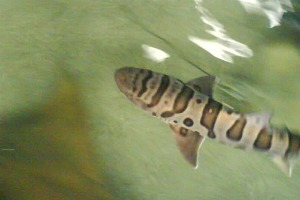 He
says this research will hopefully improve the shark repellent devices
used by scuba divers and surfers, thus helping to protect future
generations of sharks. Image: Ken SchultzNEW research shows banded bamboo sharks (Chiloscyllium punctatum) are able to sense predators while still in the embryonic state.
He
says this research will hopefully improve the shark repellent devices
used by scuba divers and surfers, thus helping to protect future
generations of sharks. Image: Ken SchultzNEW research shows banded bamboo sharks (Chiloscyllium punctatum) are able to sense predators while still in the embryonic state.
Marine neuro-ecologist Ryan Kempster, a UWA Oceans Institute PhD student, says the sharks use electrical sensors to detect predators, and are able to cease respiration to avoid detection.
“Unlike most sharks, this species will develop completely independently of their mother inside an egg case,” he says.
Mr Kempster says the embryos, which had to survive for up to five months until they were strong enough to emerge, became very still when predators were near.
“Externally they will stop any bodily movements and they stop respiring,” he says.
“Under those sorts of predatory conditions certain animals are able to slow down their heart rate.”
He says more research was needed to confirm whether or not this was the case with the sharks.
He says bamboo sharks, which are found in waters off the north-east Australian coast, sense minute electrical emissions from predators.
They are able to do so using organs called the Ampullae of Lorenzini which are a feature common to shark species.
“They are tiny pores positioned all over the surface of the heads in sharks,” he says.
“These tiny pores vary between sharks in terms of the size and the quantity.
“These are factors that might then influence how the sharks might use their sensory system.”
He says it was important to see whether there were differences in the ways various shark species reacted to electro-fields.
“A bamboo (shark) may react differently to a reef shark, and a reef shark may react differently to a white shark,” he says.
He says this research will hopefully improve the shark repellent devices used by scuba divers and surfers, thus helping to protect future generations of sharks.
“We have looked so far at Port Jackson sharks, bamboo sharks, Shovel-nosed rays, and we have colleagues in other parts of the lab that have worked on sawfish and other species.”
He says UnderWater World at Mooloolaba on Queensland’s Sunshine Coast supplies the bamboo shark embryos.
Mr Kempster has made a short film called Survival of the Stillest: Predator Avoidance in Embryonic bamboo sharks which will screen at the Beneath the Waves Film Festival at Nauticus Museum in Norfolk, Virginia on March 23 and 24.
The Festival is held in conjunction with the 41st Benthic Ecology Meeting at Old Dominion University.
The film is also available on YouTube










